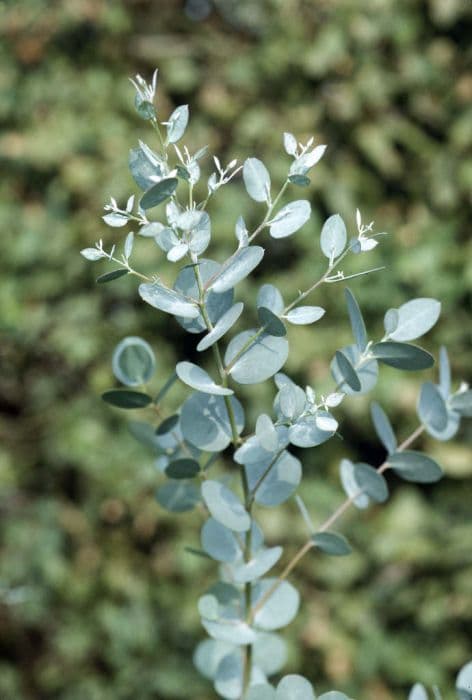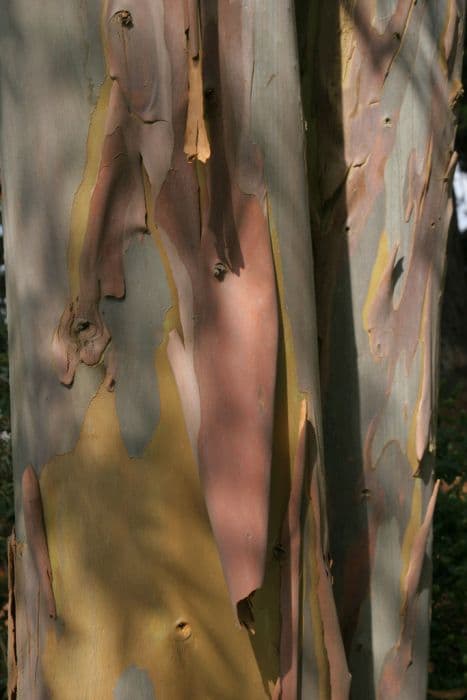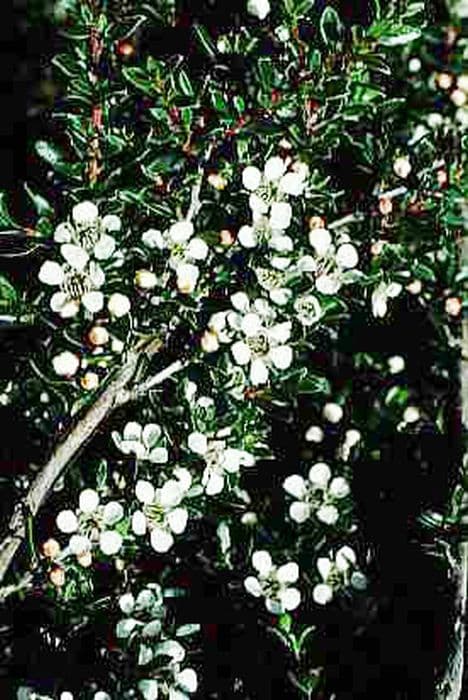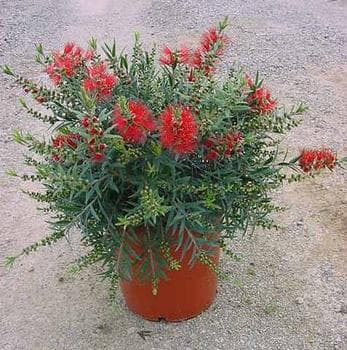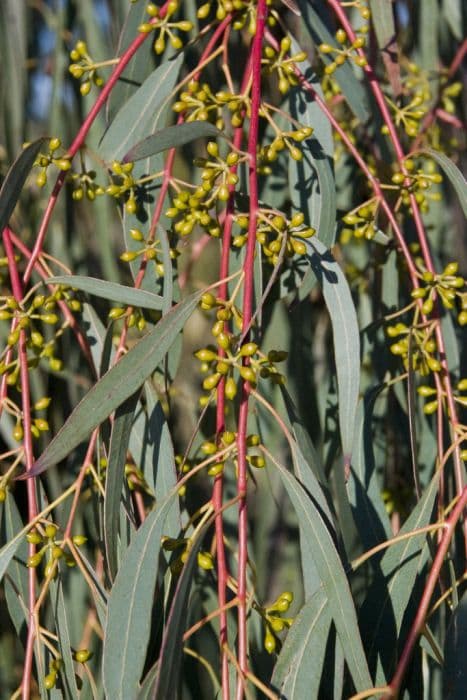Bottlebrush Callistemon 'Mauve Mist'

ABOUT
Callistemon 'Mauve Mist', also known as the Bottlebrush, is known for its distinctive brush-like flowers, which bloom in a muted mauve color, giving the plant its name. The plant boasts a profusion of soft, fine-textured foliage that's a pleasing green hue. The leaves are narrow, elongated, and slightly pointy at the ends, typically growing in an alternating pattern along the branches. This foliage provides a splendid backdrop for its vibrant and cylindrical flowers, which resemble the brushes used to clean bottles - hence its common name. These inflorescences are composed of numerous long and slender individual flowers, each contributing to the overall fluffiness and sizeable brush-like appearance. The flowers are dense with filamentous stamens, attracting pollinators such as bees and birds. When not in bloom, the Bottlebrush still maintains visual interest with its weeping habit and evergreen leaves, which keep the plant looking lively throughout the year.
About this plant
 Names
NamesSynonyms
Bottlebrush, Mauve Mist Bottlebrush
Common names
Callistemon 'Mauve Mist'
 Toxicity
ToxicityTo humans
Bottlebrush plants such as Callistemon 'Mauve Mist' are generally considered non-toxic to humans. There is no widespread evidence or reporting of poisoning from these plants. Therefore, if ingested, this plant is not expected to cause significant symptoms or consequences due to toxicity.
To pets
Bottlebrush plants like Callistemon 'Mauve Mist' are typically not toxic to pets. There have been very few reports, if any, of poisoning associated with these plants in pets. Consequently, accidental ingestion of parts of this plant should not lead to serious illness or toxic effects in pets.
 Characteristics
CharacteristicsLife cycle
Perennials
Foliage type
Evergreen
Color of leaves
Green
Flower color
Mauve
Height
3-5 feet (0.9-1.5 meters)
Spread
2-3 feet (0.6-0.9 meters)
Plant type
Shrub
Hardiness zones
9
Native area
Australia
Benefits
 General Benefits
General Benefits- Attracts Pollinators: Callistemon Mauve Mist, commonly known as Bottlebrush, produces flowers that attract bees, butterflies, and other beneficial insects.
- Drought Tolerance: Bottlebrush plants are known for their ability to withstand dry conditions once established, making them suitable for water-wise gardens.
- Low Maintenance: They require minimal pruning and care, making them an easy choice for gardeners of all skill levels.
- Landscape Ornamentation: With its mauve-colored brush-like flowers, this Bottlebrush variety adds a unique aesthetic value to landscaping.
- Fast Growth: Bottlebrush plants typically grow quickly, providing swift gratification in terms of achieving a mature garden appearance.
- Habitat for Wildlife: These plants can offer shelter and food for wildlife, including birds that feed on the nectar.
- Adaptable to Various Soils: Bottlebrush plants can thrive in a variety of soil types, although well-draining soil is preferred.
- Coastal Suitability: Being tolerant to sea spray and salty soils, they are ideal for coastal gardens.
- Evergreen Foliage: Bottlebrush plants maintain their foliage throughout the year, providing constant greenery in the garden.
- No Known Invasiveness: Bottlebrushes are not generally considered invasive, reducing the risk of them spreading uncontrollably.
 Medical Properties
Medical PropertiesThis plant is not used for medical purposes.
 Air-purifying Qualities
Air-purifying QualitiesThis plant is not specifically known for air purifying qualities.
 Other Uses
Other Uses- Artistic Inspirations: The unique mauve flowers of the Callistemon 'Mauve Mist' can serve as a striking subject for photography, painting, and other forms of visual arts.
- Educational Tool: This plant can be utilized in educational programs for teaching botany, especially concerning plant adaptations and pollination mechanisms.
- Privacy Screening: With its dense foliage, Callistemon 'Mauve Mist' can be grown as a privacy screen in gardens, blocking the view from neighbors or passers-by.
- Theme Gardens: Its distinct mauve flowers make it a fitting addition to color-themed gardens where mauve or purple is the highlight.
- Dye Production: The flowers may be used to create natural dyes for fabrics, crafts, or even as a biological stain for microscopy.
- Soil Erosion Control: Because of its robust rooting system, this plant can be employed in landscaping to help control soil erosion on slopes or riverbanks.
- Cultural Significance: The Callistemon 'Mauve Mist' can be incorporated into gardens for cultural events or celebrations that involve flower symbolism, especially in regions where it is indigenous.
- Event Decor: Its eye-catching flowers can be used in floral arrangements or as standalone decoration for events and celebrations.
- Culinary Experiences: The flowers, while not commonly used, could potentially be experimented with as a garnish for their visual appeal, though culinary safety should be considered.
- Wildlife Gardening: The plant can act as a habitat and food source for various insects and birds, thus contributing to the biodiversity of a garden.
Interesting Facts
 Feng Shui
Feng ShuiBottlebrush is not used in Feng Shui practice.
 Zodiac Sign Compitability
Zodiac Sign CompitabilityBottlebrush is not used in astrology practice.
 Plant Symbolism
Plant Symbolism- Resilience: Bottlebrush plants, like 'Mauve Mist', are known for their hardy nature, able to adapt and thrive in various conditions, symbolizing the ability to persevere through hardships.
- Endurance: Their persistent flowering even in tough conditions stands for endurance and the ability to withstand challenges over time.
- Cleansing: The bottlebrush flower shape is reminiscent of a brush used for cleaning, representing purification and the sweeping away of negative energies.
- Attraction: With vibrant flowers that attract pollinators, bottlebrush plants symbolize allure and the power of drawing in positive influences.
- Rejuvenation: Their prolific growth and renewal of flowers can signify new beginnings and a fresh start or recovery.
 Water
WaterBottlebrush, including 'Mauve Mist', prefers consistent moisture but does not like to be waterlogged. Water the plant deeply once a week, providing about 1 to 1.5 gallons of water each time. During hot, dry spells, increase watering frequency to twice a week. Ensure that the soil drains well to prevent root rot. During the winter, reduce the amount of water to when the top inch of soil feels dry to the touch.
 Light
LightThe Bottlebrush 'Mauve Mist' thrives in full sun conditions, requiring at least six hours of direct sunlight per day. An ideal spot would be a sunny border or an open area in the garden that receives uninterrupted sunlight. Avoid heavily shaded areas as this can lead to poor flowering and weak growth.
 Temperature
TemperatureBottlebrush 'Mauve Mist' does well in a broad range of temperatures but prefers a warmer climate. It can survive minimum temperatures down to about 20 degrees Fahrenheit but performs best when temperatures are between 50 to 90 degrees Fahrenheit. To encourage optimal growth and flowering, protect the plant from temperatures below freezing, using frost cloths if necessary.
 Pruning
PruningPrune your Bottlebrush 'Mauve Mist' to maintain its shape and encourage bushier growth. The best time to prune is after the plant has finished blooming, usually in late spring or early summer. Remove any dead or excess branches, cutting back to just above a leaf node. Pruning can be done annually, but be careful not to over-prune as this can reduce flowering.
 Cleaning
CleaningAs needed
 Soil
SoilBottlebrush 'Mauve Mist' prefers well-draining soil with a slightly acidic to neutral pH of 5.5 to 7.0. A mix of loam, sand, and peat with good organic content is ideal. Amend the soil with compost to enhance fertility and ensure good drainage.
 Repotting
RepottingBottlebrush 'Mauve Mist' should be repotted every 2-3 years, or when it becomes root-bound. Spring is the best time for repotting to allow the plant to recover during the growing season.
 Humidity & Misting
Humidity & MistingBottlebrush 'Mauve Mist' tolerates a range of humidity levels but thrives in moderate to high humidity conditions. Aim for 40-60% relative humidity for optimal growth.
 Suitable locations
Suitable locationsIndoor
Provide bright light and well-draining soil.
Outdoor
Full sun, shelter from strong winds, and well-draining soil.
Hardiness zone
9-11 USDA
 Life cycle
Life cycleThe Callistemon 'Mauve Mist', commonly known as the Bottlebrush, begins its life as a seed, often requiring stratification or pre-treatment to break dormancy and promote germination. When environmental conditions are favorable, typically in spring, the seed germinates and develops into a seedling. The seedling grows into a juvenile plant, establishing a root system and beginning to produce the distinctive foliage and the young, immature form of the characteristic bottlebrush-shaped flowers. As the plant matures over several years, it enters the adult phase, characterized by robust growth and full-sized bottlebrush flowers that range in color from mauve to purple, attracting birds and pollinators. Following the flowering period, the plant produces capsules that contain seeds, which can be disseminated by wind or animals, allowing for the potential colonization of new areas. As a perennial shrub, the Bottlebrush can live for many years, going through annual cycles of flowering and seed production.
 Propogation
PropogationPropogation time
Spring-Early Summer
The Callistemon 'Mauve Mist', commonly known as the Mauve Mist Bottlebrush, is best propagated through semi-hardwood cuttings. The optimal time for taking cuttings is in the late summer or early fall when the plant's growth begins to slow. To propagate, select a healthy branch and cut a 4 to 6-inch (approximately 10 to 15 cm) section with several sets of leaves. The cut end is then dipped in rooting hormone to encourage root development and placed in a well-draining potting mix or a mixture of perlite and peat. The cutting should be kept moist, but not waterlogged, and placed in a warm spot with indirect sunlight. A makeshift greenhouse created by covering the pot with a plastic bag can help maintain humidity levels conducive to rooting. With proper care, the cutting should develop roots in a few weeks, after which it can be transferred to a larger pot and eventually planted out.
